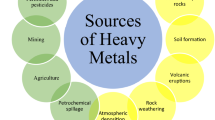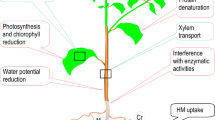Abstract
Commercial phosphate (P) fertilizers contain small amounts of heavy-metal contaminants which were minor constituents in phosphate rock (PR). Animal manures and sewage sludges (biosolids) are the main organic fertilizers and the latter also may contain heavy-metal contaminants. Heavy metals in biosolids may be found in the inorganic form or may be organically complexed, which could affect their chemical reactions in soil. These heavy metals may accumulate in soil with repeated fertilizer applications. Cadmium (Cd) is the heavy metal of most concern because it may affect human health. Other heavy metals of possible significance are arsenic (As), chromium (Cr), lead (Pb), mercury (Hg), nickel (Ni), and vanadium (V). Some countries have set tolerance limits on heavy-metal additions to soil because their long-term effects are unknown. These limits usually are set for the tillage layer (surface 20–30 cm) of soil where most root activity occurs. Controls on heavy-metal concentrations in sewage biosolids and their maximum total and annual loading rates to soil have been imposed in some countries. Regulations also have been proposed for phased-in limits on maximum heavy metal concentrations permitted in P fertilizers, or they are already in effect. Most of the fertilizer regulations relate Cd limits to P concentrations, so P application rates dictate Cd inputs to soil. Regulations affecting sewage biosolids include a number of heavy metals, while those concerning P fertilizers only include limits on Cd at this time.
Similar content being viewed by others
References
Anon. (1989) Cadmium in phosphates: One part of a wider environmental problem. Phosphorus and Potassium 162 (4): 23–30
Anon. (1990) The 1990 Australian market basket survey report. National Health and Medical Council, National Food Authority. Australian Government Publishing Company, Canberra
Benchekroun A (1992) Identifying and managing the environmental issues facing the phosphate fertilizer production sector - the viewpoint of the World Phosphate Institute. In: Schultz JJ (ed) Phosphate Fertilizers and the Environment, pp 143–146. Spec. Pub. IFDC-SP-18, Int. Fert. Dev. Ctr., Muscle Shoals, AL
Chaney RL (1983) Potential effects of waste constituents on the food chain. In: Parr JF (ed) Land Treatment of Hazardous Wastes, pp 50–76. Noyes Data Corp. Park Ridge, New Jersey
Chaney RL, Bruins RJF, Baker DE, Korcak RF, Smith JE and Cole D (1987) Transfer of sludge applied trace elements to the food chain. In: Page ALet al. (eds) Land Application of Sludge, pp 67–99. Lewis Publishers, Chelsea, MI
Finck A (1992) Dünger und Düngung: Grundlagen und Anleitung zur Düngung der Kulturpflanzer (2nd Ed), pp 389–395. VCH Verlagsgesellschaft mbH, Weinheim, Germany
Hutton M (1982) Cadmium in the European community: A prospective assessment of sources, human exposure and environmental impact. Comm. of the European Communities. Tech. Rept. 33-ENV U.K., Chelsea College, Univ. of London, England
Isermann K (1982) Effect of phosphate fertilization on the cadmium content of soil determined on the basis of numerous long-term trials in Western Europe. Landwirtsch Forsch Sonderh 39: 283–301
Jaakola A (1977) Effect of fertilizers, lime and cadmium added to soil on the cadmium content of spring wheat. J Sci Agric Soc Finl 49: 406–414
Johnston AE and Jones KC (1992) The cadmium issue - long-term changes in the cadmium content of soils and the crops grown on them. In: Schultz JJ (ed) Phosphate Fertilizers and the Environment, pp 255–269. Spec Pub. IFDC-SP-18, Int. Fert. Develop. Ctr., Muscle Shoals, AL
Kongshaug G, Bockman OC, Kaarstad O and Morka H (1992) Inputs of trace elements to soils and plants. Proc. Chemical Climatology and Geomedical Problems, Norsk Hydro, Oslo, Norway
Logan TJ and Chaney RL (1983) Utilization of municipal wastewater and sludge on land-metals. In: Page ALet al. (eds) Utilization of Municipal Wastewater and Sludge on Land, pp 253–326. University of California, Riverside, CA
Mortvedt JJ (1987) Cadmium levels in soils and plants from some long-term soil fertility experiments in the United States of America. J Environ Qual 16: 137–142
Mortvedt JJ and Giordano PM (1977) Crop uptake of heavy-metal contaminants in fertilizers. In: Wildung RA and Drucker H (eds) Biological Implications of Heavy Metals in the Environment, pp 402–416. ERDA Rep. Conf. 750929, Oak Ridge, TN
Mortvedt JJ, Mays DA and Osborn G (1981) Uptake by wheat of cadmium and other heavy metal contaminants in phosphate fertilizers. J Environ Qual 10: 193–197
Page AL, Chang AC and El-Amamy M (1987) Cadmium levels in soil and crops in the United States. In: Hutchinson TC and Meema KM (eds) Lead, Mercury, Cadmium and Arsenic in the Environment, SCOPE 31, pp 119–146. John Wiley and Sons, New York
Rothbaum HP, Goguel RL, Johnston AE and Mattingly GEG (1986) Cadmium accumulation in soils from long-continued applications of superphospate. J Soil Sci 37: 99–107
Smani MS (1993) Removal of cadmium from phosphoric acid.In Proc. Fourth Int. Conf., Phosphorus, Life, and the Environment Sept. 8–11, 1992, Ghent, Belgium. World Phosphate Institute, Casablanca, Morocco
Smilde KW and van Luit B (1983) The effect of phosphate fertilizer cadmium on cadmium in soils and crops. Rapport Institut Bodemvruchtbaarheid no. 6-83. Haren, The Netherlands
Sommers LE (1977) Chemical composition of sewage sludges and analysis of their potential use as fertilizers. J Environ Qual 6: 225–232
United States Environmental Protection Agency (1993) Clean Water Act 40 CFR 503, Sludge Rule. U.S. Govt. Print. Off., Washington, DC
Wakefield ZT (1980) Distribution of cadmium and selected heavy metals in phosphate fertilizer processing. Bull. Y-159. National Fertilizer Development Center, Tennessee Valley Authority, Muscle Shoals, AL
Webber MD, Kloke A and Tjell J (1984) A review of current sludge use guidelines for the control of heavy metal contamination in soils. In: Hermite PL and Ott H (eds) Processing and Use of Sewage Sludge. Reidel Publishing Co., Dordrecht, The Netherlands
Williams CH and David DJ (1973) The effect of superphosphate on the cadmium content of soils and plants. Aust J Soil Res 11: 43–56
Wolnik K, Fricks FL, Capar SG, Braude GL, Meyer MW, Satzger RD and Bonner E (1983) Elements in major raw agricultural crops in the United States. 1. Cadmium and lead in lettuce, peanuts, potatoes, soybeans, sweet corn, and wheat. J Agr Food Chem 31: 1240–1244
Author information
Authors and Affiliations
Rights and permissions
About this article
Cite this article
Mortvedt, J.J. Heavy metal contaminants in inorganic and organic fertilizers. Fertilizer Research 43, 55–61 (1995). https://doi.org/10.1007/BF00747683
Issue Date:
DOI: https://doi.org/10.1007/BF00747683




